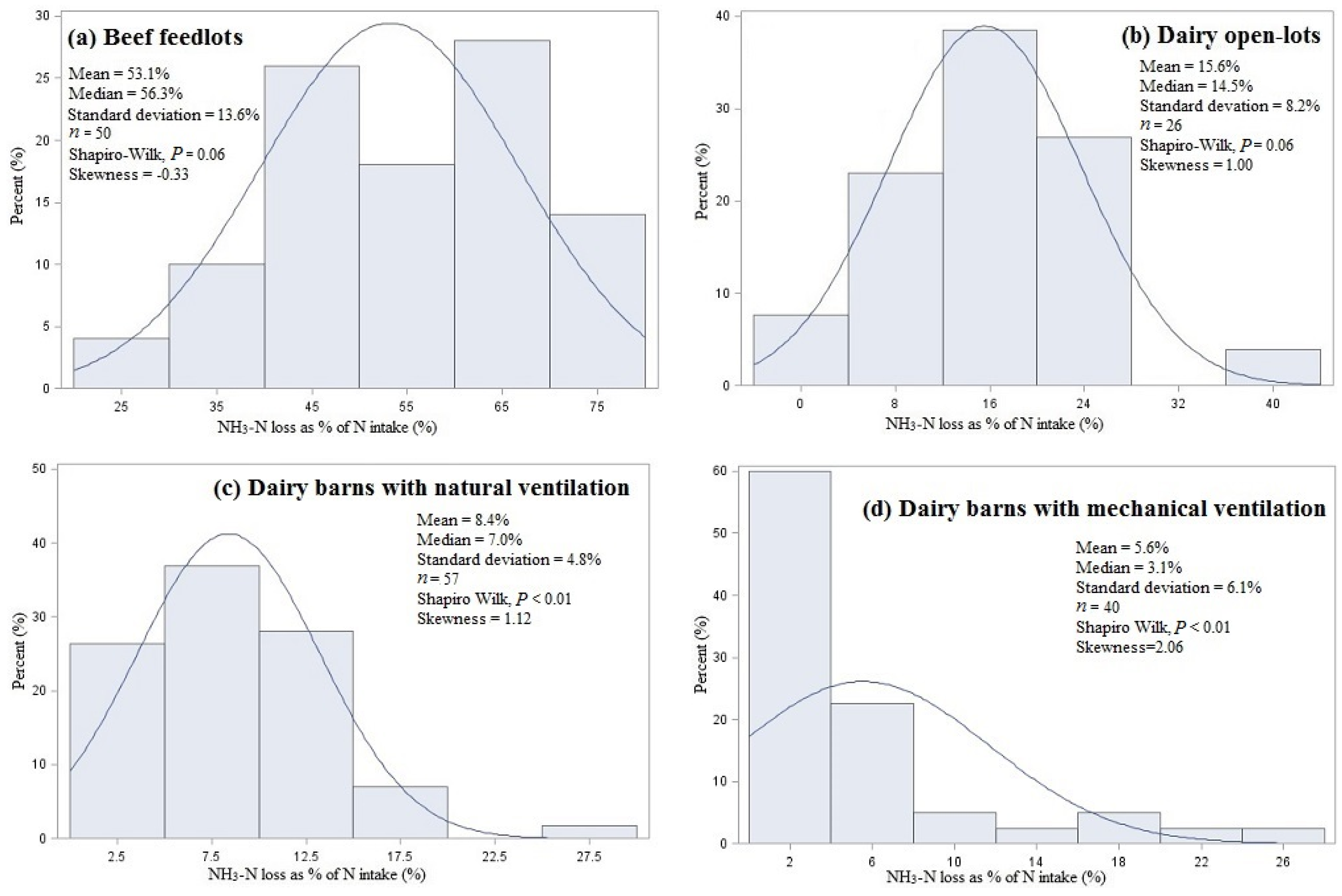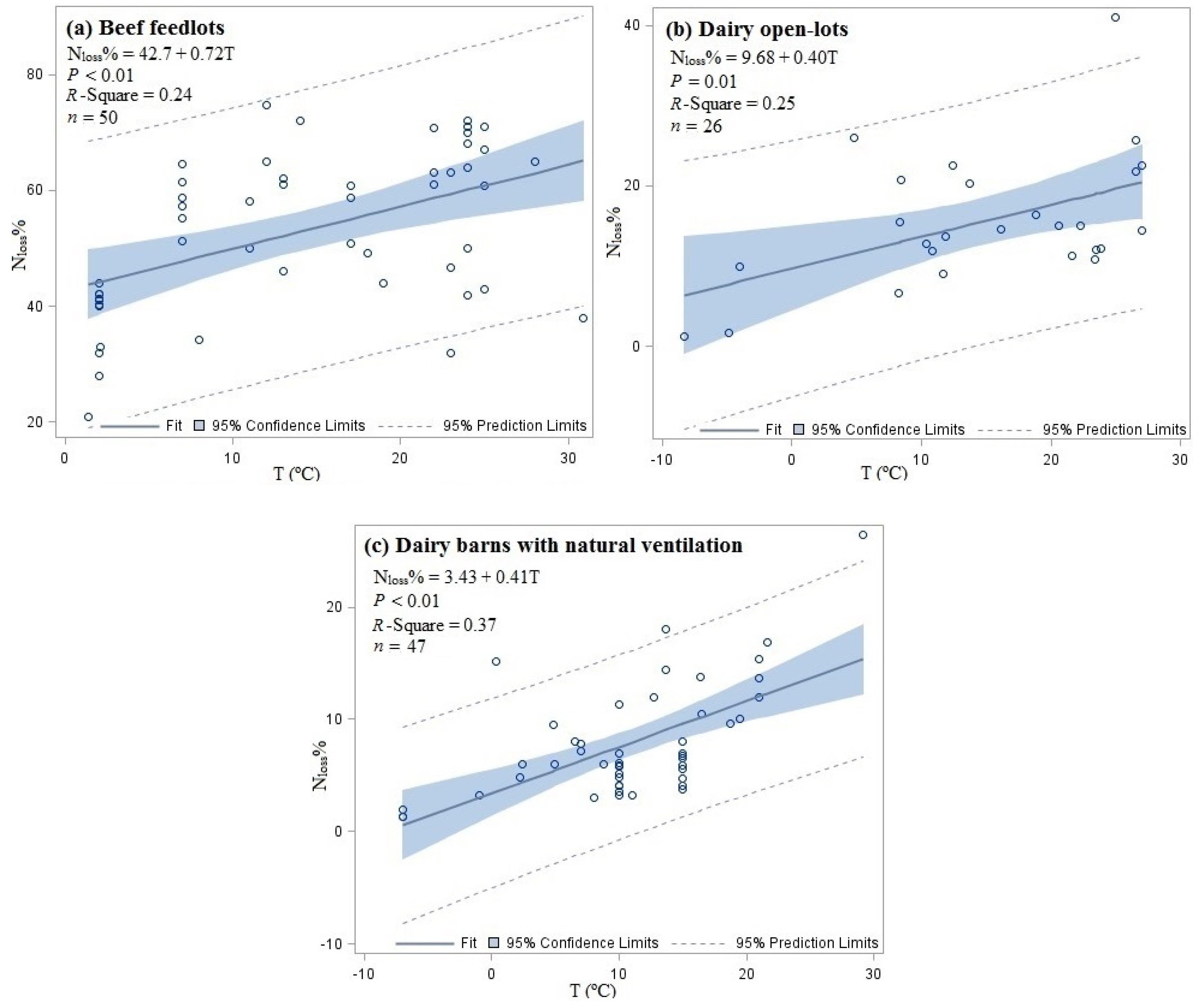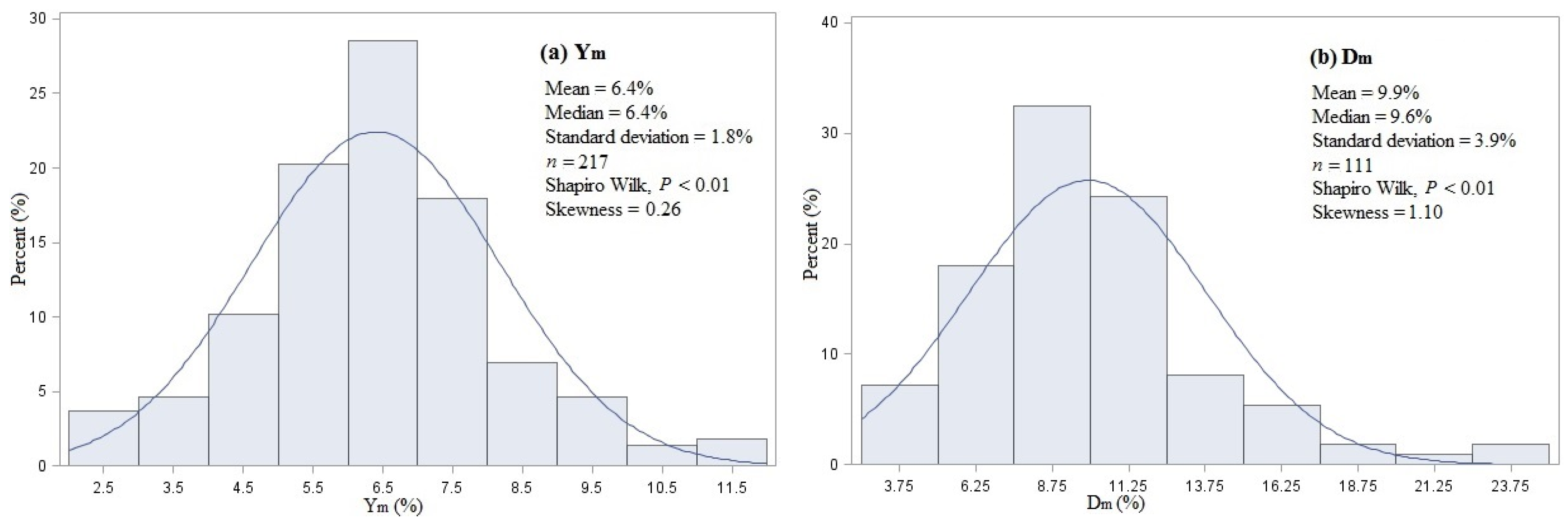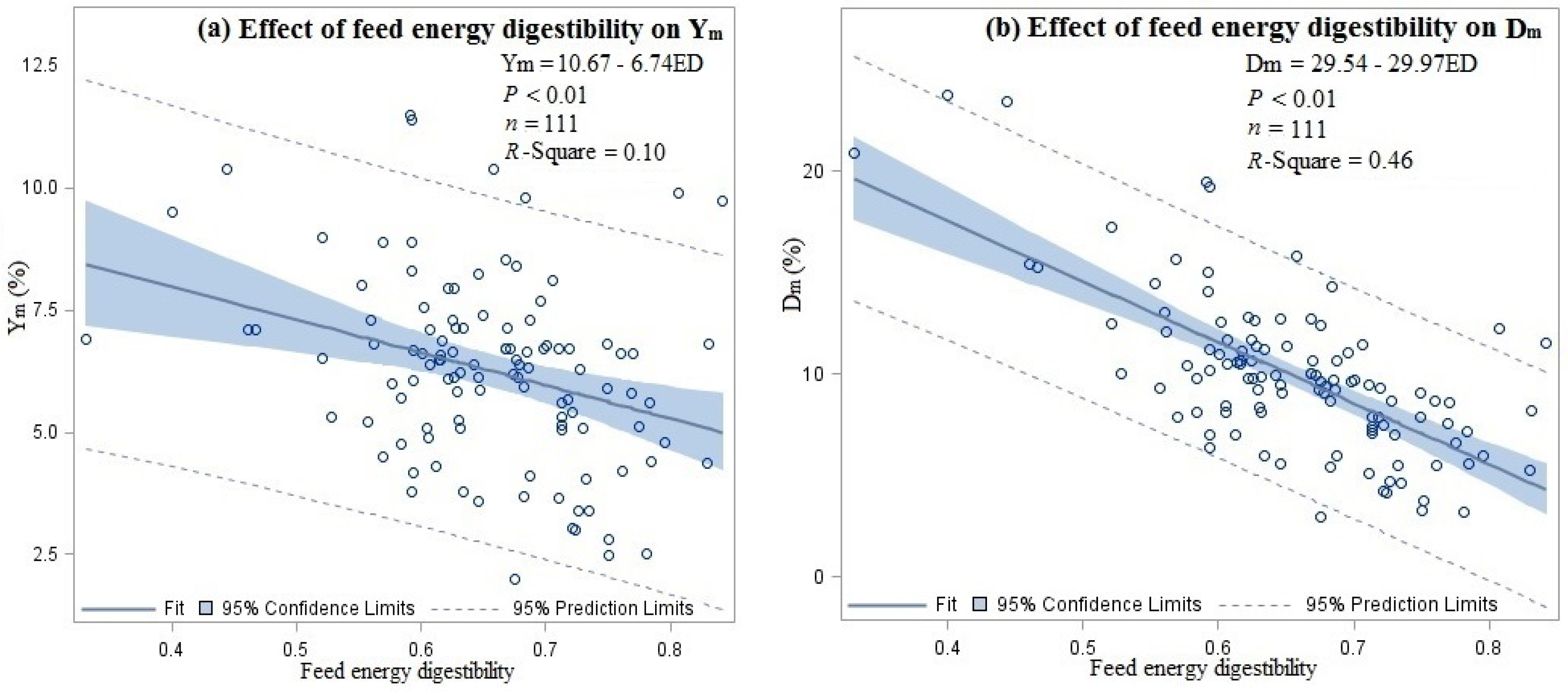Ammonia and Methane Emission Factors from Cattle Operations Expressed as Losses of Dietary Nutrients or Energy
Abstract
:1. Introduction
2. Literature Search and Data Analysis
3. NH3 Emissions as a Loss of Dietary Nutrients
3.1. Overall Statistics
3.2. Effect of Air Temperature
3.3. Effect of Dietary Crude Protein (CP) Content
3.4. Other Factors That Affect NH3 Emission
4. Enteric CH4 Emissions as a Loss of Dietary Energy
4.1. Overall Statistics
4.2. Effect of Feed Digestibility
4.3. Effect of Energy Intake
4.4. Other Factors That Affect CH4 Emission
5. Conclusions
Acknowledgments
Author Contributions
Conflicts of Interest
References
- National Research Council (NRC) of the National Academies. Air Emissions from Animal Feeding Operations: Current Knowledge, Future Needs; National Academies Press: Washington, DC, USA, 2003. [Google Scholar]
- United States Environmental Protection Agency (USEPA). Inventory of US Greenhouse Gas Emissions and Sinks: 1990–2012. 2014. Available online: https://www3.epa.gov/climatechange/Downloads/ghgemissions/US-GHG-Inventory-2014-Main-Text.pdf (accessed on 22 February 2017). [Google Scholar]
- United States Environmental Protection Agency (USEPA). 2008 National Emissions Inventory, Version 3. Technical Support Document. 2013. Available online: https://www.epa.gov/sites/production/files/2015-07/documents/2008_neiv3_tsd_draft.pdf (accessed on 22 February 2017). [Google Scholar]
- Jonker, J.S.; Kohn, R.A.; High, J. Dairy herd management practices that impact nitrogen utilization efficiency. J. Dairy Sci. 2002, 85, 1218–1226. [Google Scholar] [CrossRef]
- Liu, Z.; Powers, W.; Oldick, B.; Davidson, J.; Meyer, D. Gas emissions from dairy cows fed typical diets of midwest, south, and west regions of the United States. J. Environ. Qual. 2012, 41, 1228–1237. [Google Scholar] [CrossRef] [PubMed]
- Cole, N.A.; Todd, R.W. Nitrogen and phosphorus balance of beef cattle feedyards. In Proceedings of the Texas Animal Manure Management Issues Conference, Texas AgriLife Extension, Round Rock, TX, USA, 29 September 2009; pp. 17–24.
- James, T.; Meyer, D.; Esparza, E.; Depeters, E.J.; Perez-Monti, H. Effects of dietary nitrogen manipulation on ammonia volatilization from manure from Holstein heifers. J. Dairy Sci. 1999, 82, 2430–2439. [Google Scholar] [CrossRef]
- Todd, R.W.; Cole, N.A.; Rhoades, M.B.; Parker, D.B.; Casey, K.D. Daily, monthly, seasonal, and annual ammonia emissions from southern High Plains cattle feedyards. J. Environ. Qual. 2011, 40, 1090–1095. [Google Scholar] [CrossRef] [PubMed]
- Intergovernmental Panel on Climate Change (IPCC). IPCC Guidelines for National Greenhouse Gas Inventories; Agricultural, Forestry and Other Land Use; Institute for Global Environmental Strategies (IGES): Hayama, Japan, 2006; Volume 4. [Google Scholar]
- MidWest Plan Service (MWPS). Manure Storages; Manure management system series; MWPS-18, Section 2: Ames, IA, USA, 2001. [Google Scholar]
- Rong, L.; Nielsen, P.V.; Zhang, G. Effects of airflow and liquid temperature on ammonia mass transfer above an emission surface: Experimental study on emission rate. Bioresour. Tech. 2009, 100, 4654–4661. [Google Scholar] [CrossRef] [PubMed]
- Todd, R.W.; Cole, N.A.; Clark, R.N.; Flesch, T.K.; Harper, L.A.; Baek, B.H. Ammonia emissions from a beef cattle feedyard on the southern High Plains. Atmos. Environ. 2008, 42, 6797–6805. [Google Scholar] [CrossRef]
- Bougouin, A.; Leytem, A.B.; Dijkstra, J.; Dungan, R.S.; Kebreab, E. Nutritional and environmental effects on ammonia emissions from dairy cattle housing: A meta-analysis. J. Environ. Qual. 2016, 45, 1123–1132. [Google Scholar] [CrossRef] [PubMed]
- Waldrip, H.M.; Todd, R.W.; Cole, N.A. Prediction of nitrogen excretion by beef cattle: A meta-analysis. J. Anim. Sci. 2013, 91, 4290–4302. [Google Scholar] [CrossRef] [PubMed]
- Huhtanen, P.; Nousiainen, J.I.; Rinne, M.; Kytola, K.; Khalili, H. Utilization and partition of dietary nitrogen in dairy cows fed grass silage-based diets. J. Dairy Sci. 2008, 91, 3589–3599. [Google Scholar] [CrossRef] [PubMed]
- Misselbrook, T.H.; Powell, J.M. Influence of bedding material on ammonia emissions from cattle excreta. J. Dairy Sci. 2005, 88, 4304–4312. [Google Scholar] [CrossRef]
- Monteny, G.J.; Erisman, J.W. Ammonia emission from dairy cow buildings: A review of measurement techniques, influencing factors, and possibilities for reduction. Neth. J. Agric. Sci. 1998, 46, 225–247. [Google Scholar]
- Commonwealth Scientific and Industrial Research Organisation (CSIRO). Nutrient Requirements of Domesticated Ruminants; CSIRO Publishing: Melbourne, Australia, 2007.
- McGeough, E.J.; O’Kiely, P.; Hart, K.J.; Moloney, A.P.; Boland, T.M.; Kenny, D.A. Methane emissions, feed intake, performance, digestibility and rumen fermentation of finishing beef cattle offered whole-crop wheat silages differing in grain content. J. Anim. Sci. 2010, 88, 2703–2716. [Google Scholar] [CrossRef] [PubMed] [Green Version]
- Aguerre, M.J.; Wattiaux, M.A.; Powell, J.M.; Broderick, G.A.; Arndt, C. Effect of forage-to-concentrate ratio in dairy cow diets on emission of methane, carbon dioxide, and ammonia, lactation performance, and manure excretion. J. Dairy Sci. 2011, 94, 3081–3093. [Google Scholar] [CrossRef] [PubMed]
- Hristov, A.N.; Oh, J.; Lee, C.; Meinen, R.; Montes, F.; Ott, T.; Firkins, J.; Rotz, A.; Dell, C.; Adesogan, A.; et al. Mitigation of Greenhouse Gas Emissions in Livestock Production—A Review of Technical Options for Non-CO2 Emissions; FAO Animal Production and Health Paper; Food and Agriculture Organization of the United Nations: Rome, Italy, 2013. [Google Scholar]
- West, J.W. Factors which Influence Forage Quality and Effectiveness in Dairy Rations. In Proceedings of the Western Canadian Dairy Seminar (USA); 1998. Available online: http://www.wcds.ca/proc/1998/ch13.htm (accessed on 22 February 2017). [Google Scholar]
- Bruinenberg, M.H.; Valk, H.; Korevaar, H.; Struik, P.C. Factors affecting digestibility of temperate forages from seminatural grasslands: A review. Grass Forage Sci. 2002, 57, 292–301. [Google Scholar] [CrossRef]
- Kujawa, M.A. Energy Partitioning in Steers Fed Cottonseed Hulls or Sugar Beet Pulp. Ph.D. Thesis, Colorado State University, Ann Arbor, MI, USA, 1994. [Google Scholar]
- Diarra, B. Net Energy Value of Soybean Hulls as Feed for Sheep. Ph.D. Thesis, Colorado State University, Ann Arbor, MI, USA, 1994. [Google Scholar]
- Johnson, K.A.; Johnson, D.E. Methane Emissions from Cattle. J. Anim. Sci. 1995, 73, 2483–2492. [Google Scholar] [CrossRef] [PubMed]
- Sauvant, D.; Giger-Reverdin, S. Modelling of digestive interactions and methane production in ruminants. Prod. Anim. 2009, 22, 375–384. [Google Scholar]
- National Research Council. Nutrient Requirements of Dairy Cattle, 7th ed.; National Academies Press: Washington, DC, USA, 2001. [Google Scholar]
- Huhtanen, P.; Rinne, M.; Nousiainen, J. A meta-analysis of feed digestion in dairy cows. 2. The effects of feeding level and diet composition on digestibility. J. Dairy Sci. 2009, 92, 5031–5042. [Google Scholar] [CrossRef] [PubMed]
- Agricultural Research Council (Great Britain). The Nutrient Requirements of Ruminant Livestock: Technical Review (No. 2); Commonwealth Agricultural Bureaux: Slough, UK, 1980. [Google Scholar]
- Boadi, D.A.; Wittenberg, K.M. Methane production from dairy and beef heifers fed forages differing in nutrient density using the sulphur hexafluoride (SF6) tracer gas technique. Can. J. Anim. Sci. 2002, 82, 201–206. [Google Scholar] [CrossRef]
- Kennedy, P.M.; Charmley, E. Methane yields from Brahman cattle fed tropical grasses and legumes. Anim. Prod. Sci. 2012, 52, 225–239. [Google Scholar] [CrossRef]
- Grainger, C.; Williams, R.; Clarke, T.; Wright, A.D.G.; Eckard, R.J. Supplementation with whole cottonseed causes long-term reduction of methane emissions from lactating dairy cows offered a forage and cereal grain diet. J. Dairy Sci. 2010, 93, 2612–2619. [Google Scholar] [CrossRef] [PubMed]
- Moate, P.J.; Williams, S.R.O.; Grainger, C.; Hannah, M.C.; Ponnampalam, E.N.; Eckard, R.J. Influence of cold-pressed canola, brewers grains and hominy meal as dietary supplements suitable for reducing enteric methane emissions from lactating dairy cows. Anim. Feed Sci. Technol. 2011, 166–167, 254–264. [Google Scholar] [CrossRef]
- Doreau, M.; Chilliard, Y.; Bauchart, D.; Michalet-Doreau, B.; Fléchet, J.; Lefaivre, R.; Legay, C.; Meyer, M.; Ollier, A. Influence of different fat supplements on digestibility and ruminal digestion in cows. Ann. Zootech. INRA/EDP Sci. 1991, 40, 19–30. [Google Scholar] [CrossRef]
- Smits, M.C.J.; Monteny, G.J.; van Duinkerken, G. Effect of nutrition and management factors on ammonia emission from dairy cow herds: Models and field observations. Livest. Prod. Sci. 2003, 84, 113–123. [Google Scholar] [CrossRef]







© 2017 by the authors. Licensee MDPI, Basel, Switzerland. This article is an open access article distributed under the terms and conditions of the Creative Commons Attribution (CC BY) license ( http://creativecommons.org/licenses/by/4.0/).
Share and Cite
Liu, Z.; Liu, Y.; Murphy, J.P.; Maghirang, R. Ammonia and Methane Emission Factors from Cattle Operations Expressed as Losses of Dietary Nutrients or Energy. Agriculture 2017, 7, 16. https://doi.org/10.3390/agriculture7030016
Liu Z, Liu Y, Murphy JP, Maghirang R. Ammonia and Methane Emission Factors from Cattle Operations Expressed as Losses of Dietary Nutrients or Energy. Agriculture. 2017; 7(3):16. https://doi.org/10.3390/agriculture7030016
Chicago/Turabian StyleLiu, Zifei, Yang Liu, James P. Murphy, and Ronaldo Maghirang. 2017. "Ammonia and Methane Emission Factors from Cattle Operations Expressed as Losses of Dietary Nutrients or Energy" Agriculture 7, no. 3: 16. https://doi.org/10.3390/agriculture7030016





